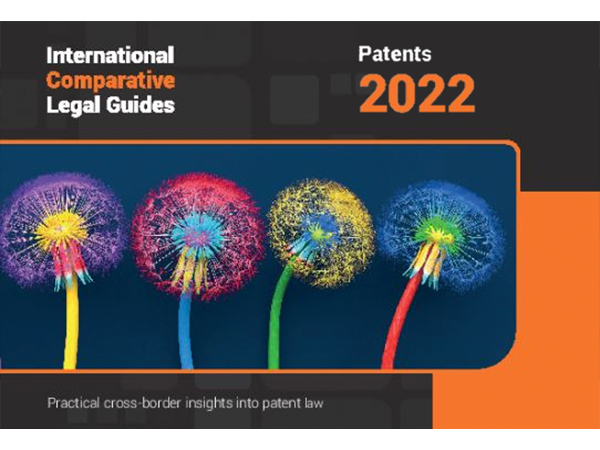
Intellectual Property
Viewpoints
Filter by:
Under New Guidance: Patent Eligibility of Computerized Diagnostics at the PTAB
May 15, 2019 | Blog | By Ken Jenkins
We previously reported here on a Patent Trial and Appeal Board (PTAB) decision involving a case in which a patent eligibility rejection was overcome by replacing a “comparing” step with a recitation that the sample is from a particular patient population. However, because the eligibility rejection was dropped by the examiner before appeal, the PTAB did not revisit the issue.
Read more
District Court of Delaware awards an ongoing royalty that applies not just to adjudicated products but also to non-adjudicated products that are “not colorably different.”
May 13, 2019 | Blog | By Michael Renaud, Sandra Badin
Recently, in Godo Kaisha IP Bridge 1 v. TCL Commc’n Tech. Holdings Ltd., the Delaware District Court awarded the prevailing plaintiff in a patent infringement suit an ongoing royalty that covers not only the products adjudicated to infringe but also non-adjudicated products that were “not colorably different” from the adjudicated products. The court noted that the patent claims asserted by the plaintiff, IP Bridge, were found to be essential to the LTE standard because LTE phones do not operate on the LTE network without infringing the asserted claims.
Read more
Where Both Parties Behave Badly in Litigation, Attorneys’ Fees Are Unlikely to Be Awarded
May 7, 2019 | Blog | By Andrew DeVoogd
On April 25, 2019, in Int’l Designs Corp., LLC, et. al. v. Hair Art Int’l, Inc., Judge George H. Wu in the Central District of California denied Hair Art’s motion for attorneys’ fees under 35 U.S.C. § 285. Judge Wu concluded that, based on an analysis of the totality of the circumstances, “[t]his case was certainly ‘exceptional,’ but it was exceptional in that both parties made litigation choices leading to a significant waste of party and judicial resources.” (Emphasis added.)
Read more
Dueling Declaratory Judgment Suits Result in a Dismissal and Boomerang Transfer Back to the First-filed Forum Under TC Heartland
April 24, 2019 | Blog | By Adam Samansky, Peter Cuomo, Joe Rutkowski
On April 17, 2019, Judge Gilstrap of the United States District Court for the Eastern District of Texas, in Apicore v. Beloteca, No. 19-cv-00077, held that while the court could exercise personal jurisdiction over a generic drug manufacturer in connection with the patentee’s action seeking a declaratory judgment of noninfringement, venue was not appropriate in the Eastern District of Texas under the applicable patent venue statute, 28 U.S.C. § 1400(b).
Read more
Understanding Antedating of a Prior Art Reference for a Patent
April 17, 2019 | Blog | By Christina Sperry
The Federal Circuit’s decision in ATI Technologies ULC v. Iancu (April 11, 2019) highlights the proper standard to use in evaluating whether a claimed invention was reduced to practice before the effective date of a prior art reference.
Read more
Collateral Estoppel Bars Assertion of Patent Claims That Do Not “Materially Alter the Question of Invalidity” Relative to Claims Invalidated in IPR Proceedings
April 10, 2019 | Blog | By Peter Snell
On April 4, 2019, Chief Judge Patti Saris of the United States District Court for the District of Massachusetts held in Intellectual Ventures I, LLC v. Lenovo Group Ltd. that a final determination of invalidity in inter partes review proceedings (“IPR”) collaterally estops the patent owner from asserting in district court another claim of the same patent that does not “materially alter the question of invalidity.” The court granted the defendant’s motion for summary judgment of invalidity as to that claim.
Read more
Patent Claim Preamble Lessons from Arctic Cat Inc. v. GEP Power Products
April 9, 2019 | Blog | By Christina Sperry
The general rule is that a patent claim’s preamble does not limit the claim unless the preamble gives life, meaning, and vitality to the claim. The Federal Circuit’s recent decision in Arctic Cat Inc. v. GEP Power Products, Inc. (March 26, 2019) considers the situation where a patentee wants a preamble to be a required claim limitation, unlike the more typical situation where a patentee does not want a claim preamble to be limiting, such as in Pacing Technologies v. Garmin International previously discussed HERE. The court deciding in Arctic Cat that the preambles at issue were not required claim limitations highlights important considerations for patent application drafting and for crafting post-issuance arguments.
Read more
When Is Pre-Acquisition Analysis of Patents Protected from Discovery During Litigation?
March 29, 2019 | Blog | By Andrew DeVoogd, Daniel Weinger
A Discovery Master in Limestone Memory Systems LLC v. Micron Tech., Inc. pending in the Central District of California recently provided additional guidance to practitioners and patent owners on this important question. The report, issued on February 19, 2019, sustained in part the plaintiff Limestone’s privilege and work product assertions related to pre-acquisition analysis of the asserted patents conducted by Acacia, Limestone’s parent company. In doing so, the report emphasized that courts have long held that attorney-client privilege may arise when a company obtains legal advice, while seeking to acquire patents, protecting from discovery communications between the acquiring company and inventors.
Read more
Expert’s Lump-sum Damage Calculation is Not Inadmissible Because it Accounts for Future Sales of Potentially Non-accused Products
March 28, 2019 | Blog | By Andrew DeVoogd, Daniel Weinger
A recent order from the District of Delaware in Evolved Wireless, LLC v. Apple Inc., No. 15-00542 (“Evolved Wireless”) provides interesting guidance regarding the use of future sales in calculating lump-sum damages.
Read more
Commission Reverses Apple Infringement Finding, Thereby Mooting the Public Interest Inquiry...For Now
March 27, 2019 | Blog | By Michael Renaud, James Wodarski, Sandra Badin
Yesterday afternoon, the International Trade Commission issued its Final Determination in Certain Mobile Electronic Devices and Radio Frequency and Process Components Thereof, 337-TA-1065. The 1065 Investigation is one of several actions Qualcomm has brought against Apple both here and abroad.
Read more
FRAND Licensing of Global Portfolios – Who Gets to Set Worldwide Rates?
March 26, 2019 | Blog | By Michael Renaud, James Wodarski, Sandra Badin
A key issue in the licensing of standard essential patents (SEPs) is whether national courts have jurisdiction to determine what constitutes a global fair, reasonable, and non-discriminatory (FRAND) license rate. The Court of Appeal in England recently held that its patent courts have such jurisdiction. In Huawei Technologies Co. Ltd. v Conversant Wireless Licensing SARL, the Court of Appeal affirmed the jurisdiction of the High Court of Justice to try a claim for the infringement of UK-designated European SEPs against Chinese as well as English defendants and to issue an injunction for the unauthorized use of the SEPs at issue. In the process, it also affirmed the High Court’s jurisdiction to determine a worldwide FRAND rate.
Read more
PanOptis’ Recent Victory against Huawei Demonstrates Why an International Enforcement Approach Is Advisable for Standard-Essential Patents
March 21, 2019 | Blog | By Michael Renaud, James Wodarski, Matthew Galica
PanOptis Patent Management, LLC (“PanOptis”) was recently awarded enhanced damages and ongoing royalties as a result of Huawei Technology Co. Ltd. (“Huawei”) infringing five of its patents, four of which were alleged to be essential to the 4G LTE technology standard. Despite the successful legal outcome, the size of PanOptis’ cumulative damages award for its standard-essential patents was less than some observers anticipated. This result emphasizes the importance of taking a global enforcement approach—leveraging international fora—to recoup meaningful compensation for standard-essential patents.
Read more
Precedential PTAB Panel Says Petitioners Can Join Their Own Earlier-Filed IPRs and Join New Issues in Limited Circumstance
March 19, 2019 | Blog | By William Meunier, Brad M Scheller
In its first decision since its inception, the Precedential Opinion Panel (“POP”) for the U.S. Patent Trial and Appeal Board (“Board”), in Proppant Express Investments, LLC v. Oren Technologies, LLC, IPR2018-00914, held that under 35 U.S.C. § 315(c) the Board has discretion to allow a party, in limited circumstances, to join its own earlier-filed inter partes review (“IPR”) and join new issues, even if the party was otherwise time-barred under 35 U.S.C. § 315(b). Specifically, the Board may use this discretion only where fairness requires it and to avoid undue prejudice to a party. The POP nevertheless denied Proppant Express Investments LLC’s (“Petitioner”) motion for joinder as Petitioner’s motion was “a result of Petitioner’s errors,” and therefore did not fall within the limited circumstances it envisioned.
Read more
Cert. Denied – Patent Owners Still Must Prove Unpatented Features Did Not Drive Consumer Purchasing to Rely on EMVR
March 18, 2019 | Blog
On February 25, 2019, the Supreme Court denied Power Integrations, Inc.’s (“Power Integrations”) petition for writ of certiorari. The question presented to the Court was whether a plaintiff who had proven customer demand for an infringing product as a result of the patented feature was entitled to damages based on the entire market value of the product, or if the plaintiff also had to prove that the other unpatented features of the infringing product did not drive customer demand. The Court’s denial leaves a high burden for patentee’s relying on the Entire Market Value Rule (“EMVR”).
Read more
The FUCT Mark: Is the Prohibition on Scandalous Marks Unconstitutional?
March 14, 2019 | Blog | By Susan Neuberger Weller, Adam Samansky, Serge Subach
The constitutionality of yet another portion of Section 2(a) of the Lanham Act will soon be determined. Following in the footsteps of the blockbuster decision in Matal v. Tam, 137 S. Ct. 1744 (2017) (“Tam”), the U.S. Supreme Court granted certiorari to Iancu v. Brunetti on January 4, 2019. In Matal v. Tam, the Supreme Court held that the prohibition in Section 2(a) of the Lanham Act against registering disparaging trademarks at the U.S. Trademark Office (“USPTO”) was an unconstitutional restriction on free speech. However, Section 2(a) also prohibits the registration of other categories of marks, including marks that are immoral and scandalous. It is the constitutionality of this prohibition which is at issue in Brunetti.
Read more
Designing Around a Monopoly: the Public Interest Dispute between Qualcomm and Apple Takes a New Turn
March 12, 2019 | Blog | By Michael Renaud, James Wodarski, Sandra Badin, Matthew Galica
As we mentioned in December, the International Trade Commission issued a notice to review the Final Initial Determination and Recommended Determination issued by Administrative Law Judge Pender in Certain Mobile Electronic Devices and Radio Frequency and Process Components Thereof, 337-TA-1065 (“Certain Mobile Electronic Devices”), in which, despite finding that a valid patent was infringed and all jurisdictional requirements met, ALJ Pender had recommended that no exclusion order be issued against Apple because such an order would be contrary to the public interest.
Read more
U.S. Supreme Court Holds That Copyrights Must Be Registered before Plaintiffs Can File Infringement Suits
March 5, 2019 | Blog | By Susan Neuberger Weller, Andrew D. Skale
The U.S. Supreme Court held today that bringing a suit for copyright infringement requires that the infringed work actually be registered with the U.S. Copyright Office, and that a mere application for registration will not suffice.
Read more
The Tall Tale of the Domestic Industry
March 4, 2019 | Blog | By Michael Renaud, James Wodarski, Marguerite McConihe, Courtney Herndon
There is a common misconception the domestic industry economic prong requirement is insurmountable and an unknowable factor in a patent infringement action at the International Trade Commission (“ITC” or “Commission”), especially for foreign-based companies or non-practicing entities (“NPEs”). This could not be further from the truth. Those in the trenches at the ITC have seen recent trends that show with effective and strategic pre-suit diligence, creative thinking, and experienced counsel, the domestic industry requirement is no bar to a successful investigation.
Read more
Northern District of California Holds That Patent Suit Against Only Foreign Entities Is Permissible Even Where Inclusion of Domestic Entities Would Alter Venue Analysis
March 1, 2019 | Blog | By Andrew DeVoogd, Daniel Weinger, Matthew Galica
A recent order from the Northern District of California in AU Optronics Corporation America v. Vista Peak Ventures, LLC, 4:18-cv-04638 (CAND 2019-02-19) (“AU Optronics”), provides further guidance for patent venue analysis post-TC Heartland. Specifically, the order teaches that bringing a patent suit against only a foreign parent company while omitting its domestic subsidiary will likely not run afoul of TC Heartland’s seminal venue holding.
Read more
Continental Circuits LLC v. Intel Corp., et al: Federal Circuit Reemphasizes Prohibition on Importing a Preferred Embodiment into Patent Claims
February 20, 2019 | Blog | By Andrew DeVoogd, Matthew Galica
The Court of Appeals for the Federal Circuit (CAFC) recently issued a precedential opinion finding that a lower court had improperly incorporated an embodiment from the specification of the asserted patents into the claims. In its decision, the CAFC reaffirmed longstanding claim construction law: the claims of a patent are interpreted in light of a specification, but not everything expressed in the specification must be read into all of the claims.
Read more
Explore Other Viewpoints:
- Antitrust
- Appellate
- Arbitration, Mediation & Alternate Dispute Resolution
- Artificial Intelligence
- Awards
- Bankruptcy & Restructuring
- California Land Use
- Class Action
- Complex Commercial Litigation
- Construction
- Consumer Product Safety
- Cross-Border Asset Recovery
- Debt Financing
- Direct Investing (M&A)
- Diversity
- EB-5 Financing
- Education & Nonprofits
- Employment
- Energy & Sustainability
- Environmental Enforcement Defense
- Environmental Law
- FDA Regulatory
- Federal Circuit Appeals
- Financial Institution Litigation
- Government Law
- Growth Equity
- Health Care
- Health Care Compliance, Fraud and Abuse, & Regulatory Counseling
- Health Care Enforcement & Investigations
- Health Care Transactions
- Health Information Privacy & Security
- IP Due Diligence
- IPRs & Other Post Grant Proceedings
- Immigration
- Insolvency & Creditor Rights Litigation
- Institutional Investor Class Action Recovery
- Insurance & Financial Services
- Insurance Consulting & Risk Management
- Insurance and Reinsurance Problem-Solving & Dispute Resolution
- Intellectual Property
- Investment Funds
- Israel
- Licensing & Technology Transactions
- Life Sciences
- Litigation & Investigations
- M&A Litigation
- ML Strategies
- Medicare, Medicaid and Commercial Coverage & Reimbursement
- Mergers & Acquisitions
- Patent Litigation
- Patent Prosecution & Strategic Counseling
- Pharmacy Benefits and PBM Contracting
- Portfolio Companies
- Privacy & Cybersecurity
- Private Client
- Private Equity
- Pro Bono
- Products Liability & Complex Tort
- Projects & Infrastructure
- Public Finance
- Real Estate Litigation
- Real Estate Transactions
- Real Estate, Construction & Infrastructure
- Retail & Consumer Products
- Securities & Capital Markets
- Securities Litigation
- Special Purpose Acquisition Company (SPACs)
- Sports & Entertainment
- Strategic IP Monetization & Licensing
- Tax
- Technology
- Technology, Communications & Media
- Technology, Communications & Media Litigation
- Trade Secrets
- Trademark & Copyright
- Trademark Litigation
- Venture Capital & Emerging Companies
- White Collar Defense & Government Investigations
- Women's Health and Technology







